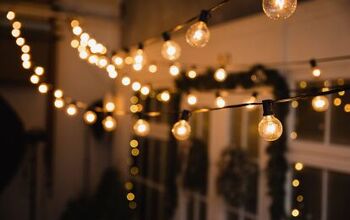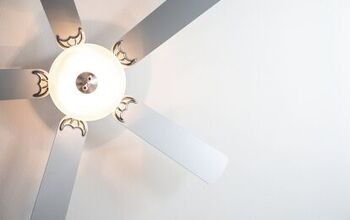Can LED Lights Catch Fire? (Find Out Now!)

I’m old enough to remember when LED lights first became truly mainstream. When LEDs lights first started hitting the market, people had so many questions about them. One of the most common things that people asked was if larger LED lights could catch fire. These cool-burning bulbs have a risky usage. In the wrong conditions, they can be more dangerous than their incandescent counterparts. But are they really that flammable?
LED bulbs do not generate enough heat to cause a fire the way that a traditional incandescent bulb does. However, this doesn’t mean that a fire can’t happen. It’s just highly unlikely. If LEDs are exposed to a high enough heat or have frayed wires, then a fire can easily happen.
A large percentage of all major house fires happen as a result of lighting fixtures that blow. It’s a good idea to know whether or not your LEDs could be contributing to a fire hazard.
Do You Need to Hire an Electrician?
Get free, zero-commitment quotes from pro contractors near you.

Are LED Lights More Flammable Than Traditional Light Bulbs?
By and large, LED lighting is far less flammable than traditional bulbs. Traditional bulbs burn in a vacuum and generate high levels of heat. LEDs do not generate nearly as much heat when they’re on. Heat-related “pops” are, therefore, highly unlikely. Even when you take into account electrical wiring causing a fire, LEDs are still somewhat safer. Overall, they’re the less flammable option.
While they are less flammable, it’s important to point out the obvious: every lightbulb can potentially catch fire in the right circumstances. It’s vital to make sure that you make your home as fire-safe as possible. This includes doing things like knowing when to use LEDs and when not to.
How To Practice Fire Safety With LED Lighting
Even though LEDs are pretty safe, you can still have a lot of problems arise from having them on for too long. There are several tips you should always keep in mind when using fire safety:
- Do not install LED lights in areas that are known for high heat. Ovens, for example, are a major no-go. If the plastic or wiring in the LEDs burst, then you would have a legitimate fire hazard on your hands in an instant. LEDs are best at room temperature or slightly above.
- Change out LED string lights and bulbs that are frayed. Frayed wires might not be as immediate a danger as high heat, but the truth is that it can still be a major hazard. Electrical wiring can corrode or even start a fire on its own accord. That’s why it’s so important to get your wall wiring fixed if it shows signs of corrosion. The same applies to LED lighting.
- If you smell smoke or notice other signs of disrepair, then remove the LED bulbs. Inspect the area around the bulb to see if your fixture has frayed wires. If not, replace the bulb.
- Don’t keep LED lights on for more than necessary. While it is rare to see LEDs light themselves on fire, the truth is that they can still pose a risk. After a certain amount of time, defective LED bulbs can generate enough heat to spark a fire. It takes a while, though, and it’s still fairly rare.
- Avoid installing LED lights or light strips near sources of heat or flammable items. For example, having a large spread of LED lights near dried, crumpled up newspaper is a bad idea. On a similar note, installing your LEDs near a heater might not be the best idea either.
How Long Can Keep LED Lights On Safely?
LED lights are great when it comes to staying power, which is actually a primary reason why they are so popular these days. Unlike incandescent bulbs, which need to have a break once in a while, LED lights can be kept on indefinitely. They do not get damaged from being shut off and on. So, you can keep them on as long as you want—though you might want to save on those electric bills by keeping them off.
Can LED String Lights Catch Fire?
LED bulbs themselves will not be very flammable, however, the string lights made with LEDs can still be a hazard. Quite a few house fires have happened as a result of having string lights that were improperly installed, frayed, or defective. The reason why is simple: the wiring in LED string lights can pose a hazard if the lights aren’t well installed.
One of the most common causes for fires related to string lights involves too much power being pumped into the lights. Check the voltage of the lights and the power source to make sure that you’re not overloading your lights.
What Should You Do If One Of Your LED Lights Catches Fire?
If you can, unplug the LED light immediately. Otherwise, grab a fire extinguisher and use it on the fire if you can. If you cannot, leave the house immediately. Do not put water on an electrical fire, as it can actually make matters worse. Call a fire department as soon as you can regardless of how big or small the fire is.
How Can You Tell If An LED Bulb Is At Risk Of Catching Fire?
Though LED bulbs rarely ever pose a risk, it can happen. This usually occurs in LED bulbs that are older or otherwise defective. There are often some telltale signs that something might be wrong. These include the following warning signs:
- The bulb in question is making strange noises. Popping, fizzing, or hissing coming from the bulb is a common sign that something isn’t quite right. If you notice this, check to see if it’s the fixture or the bulb before you assume it’s the bulb.
- The heat sink (bottom of the bulb) is beginning to look brown. A heat sink is the bottom part of the LED bulb that’s supposed to help absorb any kind of heat that the bulb generates. If it’s browning or otherwise looking burnt out, then it could be that the sink isn’t working the way it’s supposed to.
- If you pulled the bulb out of the fixture, it’s too hot to hold. This is a major warning sign that should not be ignored. LED bulbs are never supposed to get that hot. Warm? Yes. It should feel like an egg that was hard-boiled and left to cool for a bit. Hot? If you find your hand burning because you touched an LED bulb, it’s a sign that it’s about to pop. Remove the bulb immediately and discard it.
- Your LED strip has singe marks along the wiring. That’s not a good sign. This suggests that the strip that you’re using is not what it is supposed to be in terms of quality. In fact, it’s already burning on the inside. Unfortunately, this means that the entirety of the strip is no longer usable.
- There is a smell of smoke or burning plastic emanating from the light fixture. If you notice this happening, unplug the fixture and double-check to make sure it’s actually coming from the fixture. If it is, then you should do an inspection of both the bulb and the fixture to figure out which issue it is.
Do You Need to Hire an Electrician?
Get free, zero-commitment quotes from pro contractors near you.

Related Questions
Can choosing the wrong type of light bulb start a fire?
Believe it or not, choosing the wrong type of bulb isn’t just about having the wrong type of ambiance in your room. It’s also a fire hazard. Choosing a bulb that is not capable of handling the wattage from your power source drastically increases the chance of a fire. When in doubt, choose a standard wattage lightbulb or its equivalent. Better still, check the label for your lamp or light fixture—if it has one.While the chances of having a burst bulb turn into a fire are still remarkably low, the truth is that it still can happen. Safety is important, even if it means extra trips to the store.
How fast can an incandescent bulb start a fire?
An incandescent bulb that is put in the wrong socket or left wrapped in newspaper can ignite in as little as six minutes. This is why so many fire safety professionals make a point of urging people to keep their incandescent light usage to a minimum. Whenever possible, try to use LED bulbs in your home to avoid sudden fires or similar risks.
What color incandescent bulb will give off the most heat?
Believe it or not, white incandescent bulbs are not the ones that give off the most heat. They can be fairly efficient, and that means that their heat tends to be pretty stable. Colored light bulbs tend to be far hotter than their white counterparts, primarily because they are not usually meant to be as efficient. As a result, they tend to be a bigger fire risk…not to mention hotter to the touch.Using incandescent bulbs can be a risk, especially if they are colored. If possible, choose colored LEDs instead.
Related Articles

Ossiana Tepfenhart is an expert writer, focusing on interior design and general home tips. Writing is her life, and it's what she does best. Her interests include art and real estate investments.
More by Ossiana Tepfenhart


























![Standard Dining Room Table Dimensions [for 4, 6, 8, 10 and 12 People]](https://cdn-fastly.upgradedhome.com/media/2023/07/31/9074335/standard-dining-room-table-dimensions-for-4-6-8-10-and-12-people.jpg?size=350x220)
